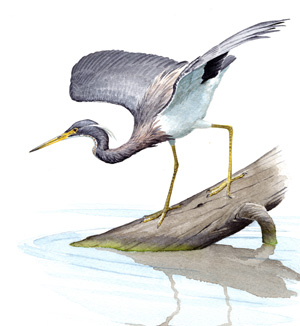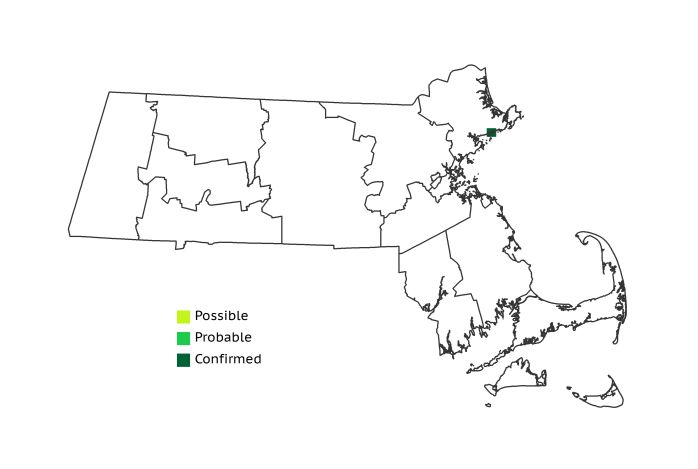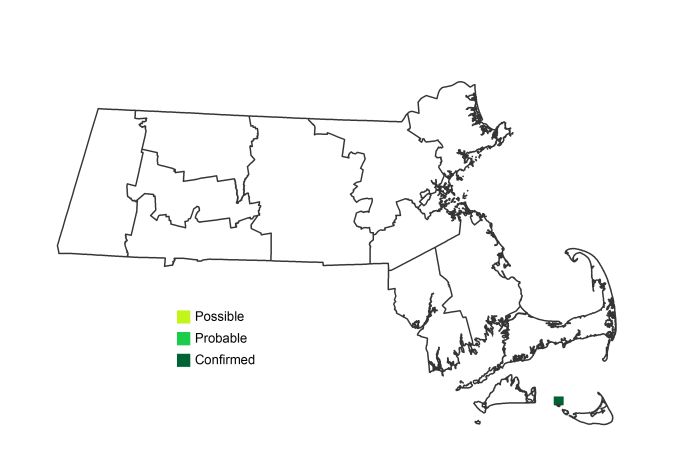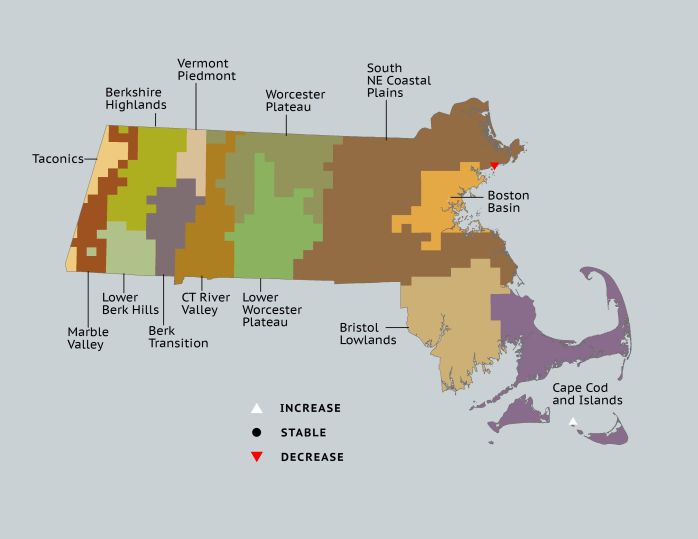Breeding Bird Atlases (BBA)
Find a Bird
Tricolored Heron
Egretta tricolor

Very local, trend not established
“Delicate in form, beautiful in plumage, and graceful in its movements, I never see this interesting Heron, without calling it the Lady of the Waters.” – John James Audubon, Birds of America
A common denizen of wetlands in the southern part of the country, the Tricolored Heron is one of three species in the genus Egretta that breeds in Massachusetts. Of the three, it is also the most recent to become a breeder in the state and, correspondingly, the least abundant. Massachusetts is on the very northern fringe of its breeding range.
Historic Status
The Tricolored, formerly known as the Louisiana Heron, first appeared in Massachusetts with a visit to Ipswich in 1940. That event took place at the dawn of a three-decade-long northern expansion of the East Coast population, as the birds eventually appeared as far north as Maine. From 1960 onward, Tricolored Herons occurred annually in the Bay State. By the early 1970s, suspicions of breeding began to arise since the species was seen regularly heading for an evening roost on Clark’s Island in Duxbury Bay along with other herons and egrets. A search, however, failed to turn up any breeding evidence (Petersen & Meservey 2003).
Atlas 1 Distribution
Not surprisingly, breeding Tricolored Herons barely registered a blip on the proverbial radar during Atlas 1. The only locality where nesting occurred during the Atlas period was at the House Island heronry just off the coast of Manchester in Essex County. Since then, at least three pairs of Tricolored Herons are known to have nested there, but despite occasional sightings no substantial evidence of breeding was recorded anywhere else in the state during Atlas 1.
Atlas 2 Distribution and Change
By the time of Atlas 2, Tricolored Herons had given up their residence at House Island, but they found a new one on Tuckernuck Island off Nantucket. At the extreme northern end of its range, the Tricolored Heron might best be considered a tale of extralimital adventure by pioneers in regard to its nesting status in Massachusetts. With the climate changing, who knows what we might expect from this species in the future?
Atlas 1 Map

Atlas 2 Map

Atlas Change Map

Ecoregion Data
Atlas 1 | Atlas 2 | Change | ||||||
Ecoregion | # Blocks | % Blocks | % of Range | # Blocks | % Blocks | % of Range | Change in # Blocks | Change in % Blocks |
Taconic Mountains | 0 | 0.0 | 0.0 | 0 | 0.0 | 0.0 | 0 | 0.0 |
Marble Valleys/Housatonic Valley | 0 | 0.0 | 0.0 | 0 | 0.0 | 0.0 | 0 | 0.0 |
Berkshire Highlands | 0 | 0.0 | 0.0 | 0 | 0.0 | 0.0 | 0 | 0.0 |
Lower Berkshire Hills | 0 | 0.0 | 0.0 | 0 | 0.0 | 0.0 | 0 | 0.0 |
Vermont Piedmont | 0 | 0.0 | 0.0 | 0 | 0.0 | 0.0 | 0 | 0.0 |
Berkshire Transition | 0 | 0.0 | 0.0 | 0 | 0.0 | 0.0 | 0 | 0.0 |
Connecticut River Valley | 0 | 0.0 | 0.0 | 0 | 0.0 | 0.0 | 0 | 0.0 |
Worcester Plateau | 0 | 0.0 | 0.0 | 0 | 0.0 | 0.0 | 0 | 0.0 |
Lower Worcester Plateau | 0 | 0.0 | 0.0 | 0 | 0.0 | 0.0 | 0 | 0.0 |
S. New England Coastal Plains and Hills | 1 | 0.4 | 100.0 | 0 | 0.0 | 0.0 | -1 | -0.4 |
Boston Basin | 0 | 0.0 | 0.0 | 0 | 0.0 | 0.0 | 0 | 0.0 |
Bristol and Narragansett Lowlands | 0 | 0.0 | 0.0 | 0 | 0.0 | 0.0 | 0 | 0.0 |
Cape Cod and Islands | 0 | 0.0 | 0.0 | 1 | 0.7 | 100.0 | 1 | 0.8 |
Statewide Total | 1 | 0.1 | 100.0 | 1 | 0.1 | 100.0 | 0 | 0.0 |
Notes
Tricolored Herons show a significant decreasing Breeding Bird Survey trend in the eastern US region.



